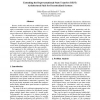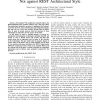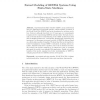13 search results - page 1 / 3 » Extending the Representational State Transfer (REST) Archite... |
ICSE
2004
IEEE-ACM
14 years 4 months ago
2004
IEEE-ACM
Because it takes time and trust to establish agreement, traditional consensus-based architectural styles cannot safely accommodate resources that change faster than it takes to tr...
COMPSAC
2010
IEEE
13 years 2 months ago
2010
IEEE
The modern Web architecture basically follows the Representational State Transfer (REST) style. This style offers the architectural properties necessary to implement the Internetsc...
ICWE
2011
Springer
12 years 8 months ago
2011
Springer
Representational State Transfer (REST), as an architectural style for distributed hypermedia systems, enables scalable operation of the World Wide Web (WWW) and is the foundation f...
INTERNET
2008
13 years 4 months ago
2008
straction and explained how the Representational State Transfer (REST) architectural style is one alternative that can yield a superior approach to building distributed systems. Be...
ECOWS
2009
Springer
13 years 11 months ago
2009
Springer
SPARQL is the standard query language for RDF, but currently is a read-only language defined in a way similar to SQL: Queries can be formulated, are submitted to a single process...



